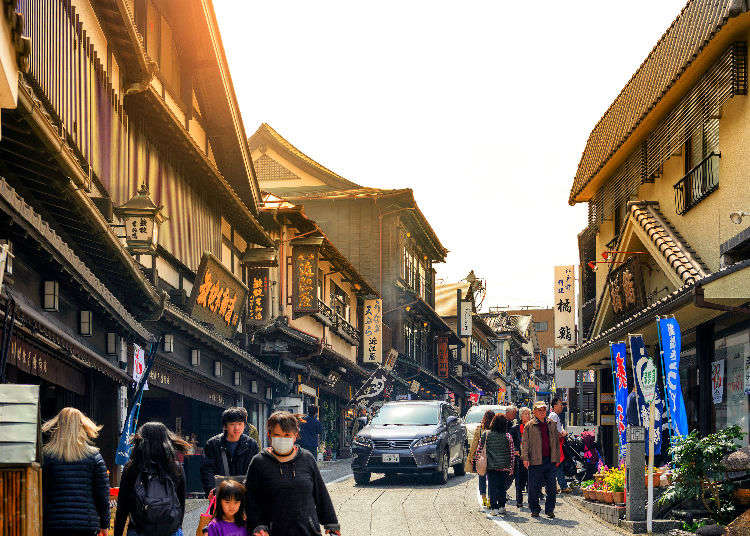
A layover at Narita Airport doesn’t mean staying stuck inside the terminal! Just 10 minutes away by train, Narita City offers a glimpse of traditional Japan. See how to make the most of your layover with these quick and enriching experiences.
Perfect Way to Spend Your Layover in Narita
Just a 10-minute train ride away from Narita Airport is Narita Station - gateway to the scenic town of Narita.
The magnificent Narita-san Shinsho-ji Temple stands there, a beautiful complex of the Buddhist Shingon sect. The street approaching this historical hot spot is called “omotesando,” home to numerous shops and stalls offering local delicacies and delights.
From Narita’s specialty unaji, broiled eel served on rice in a lacquered box, to homemade rice cakes and dumplings. Look forward to an authentic Japanese gourmet, shopping, and sightseeing experience!
The way to Narita-san Shinsho-ji Temple is about a kilometer long and the latter half, a gentle downhill slope, is particularly lively. If you have a long layover at Narita Airport or are staying at a hotel in the area, do make use of the free guided tours of the Narita Airport Transit & Stay Program!
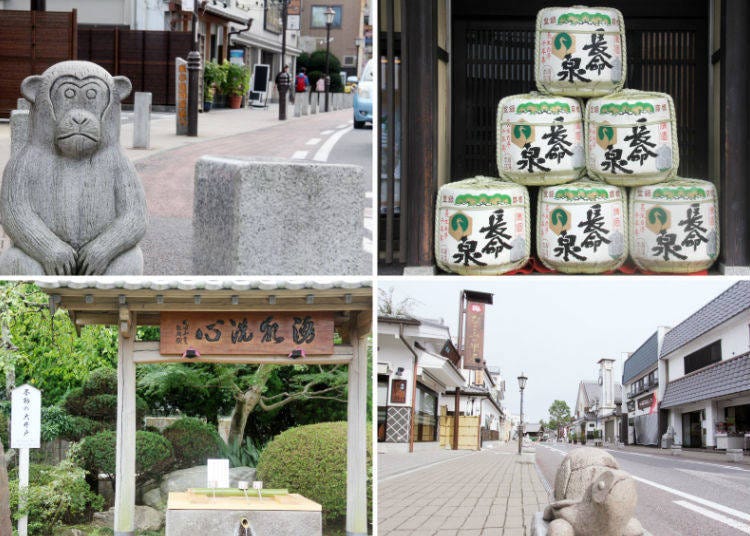
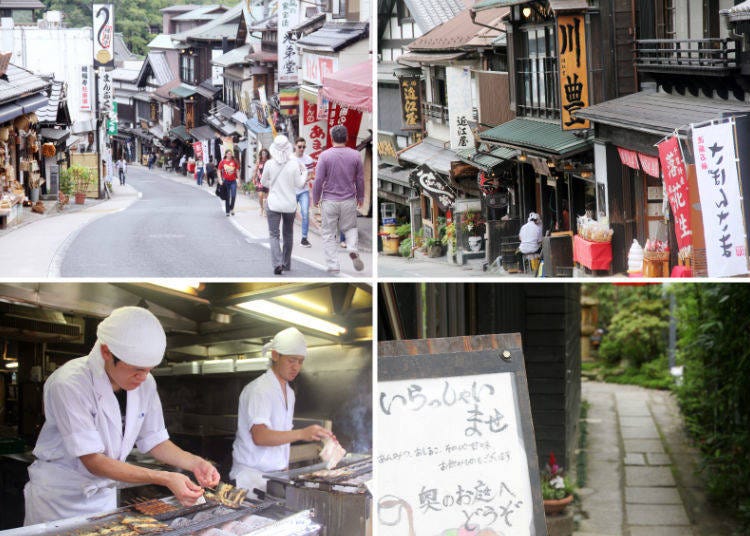
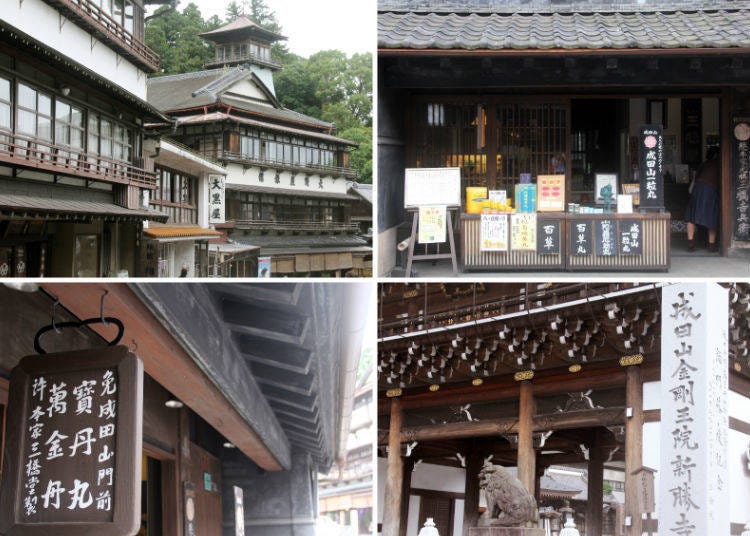
Kawatoyo: Tasting Traditional Japanese Eel with a Secret Sauce!
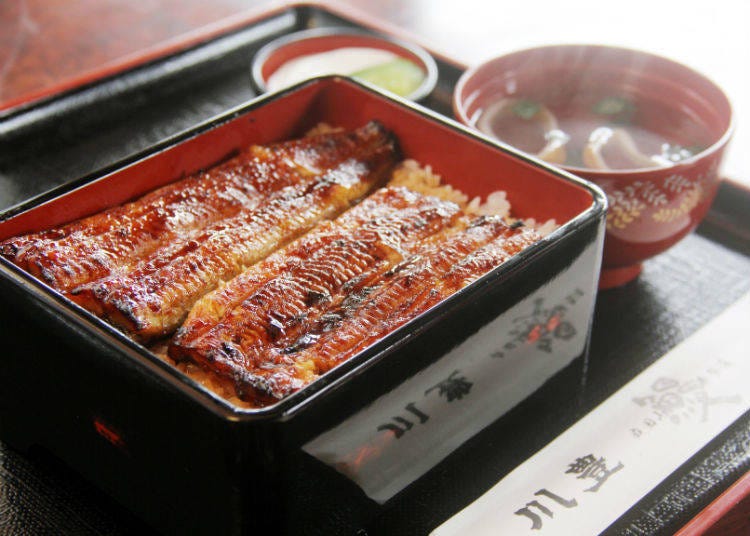
Narita’s specialty called unaju, broiled eel on rice in a lacquered box, has been made popular by the countless worshipers coming to the temple since ancient times. Even today, it is said that there are about 60 different shops serving unagi along omotesando, as the road approaching the temple is called. Among them – and arguably the most famous one – is Kawatoyo, founded in 1910 as a freshwater fish specialty store.
The freshly caught eel is prepared with a sharp kitchen knife and skewered, then carefully grilled while being covered in the shop’s special, secret sauce. This gives the eel an especially puffy texture. Continuously adding the secret sauce is a technique Kawatoyo uses since its founding – it causes the eel extract to be drawn out of the fish, making for a wonderfully mellow taste.
Three types of grilled eel are on Kawatoyo’s menu: unaju for 2,500 yen, jo-unaju (more eel) for 3,100 yen, and tokujo-unaju (even MORE eel!) for 4,100 yen. Among these options, jo-unaju is by far the most popular one. Enjoying this traditional eel dish in a 100-year old building steeped in history only adds to the delicious flavor!
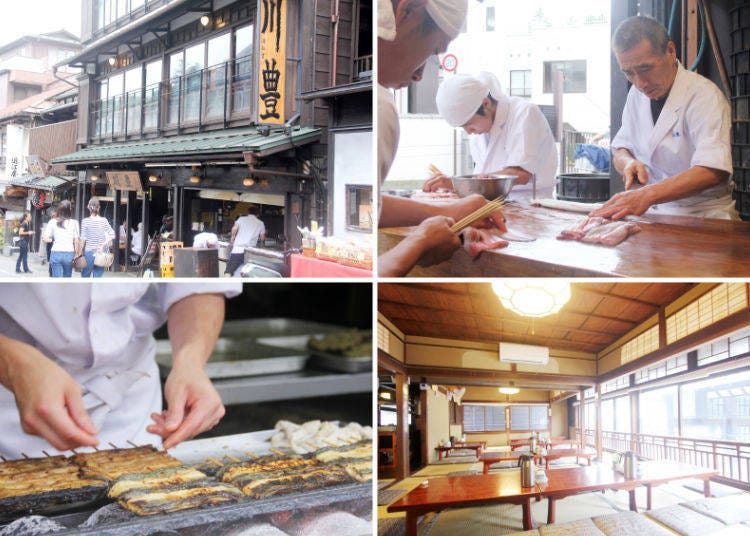
-
Kawatoyo川豊
- Address 386 Nakamachi, Narita-City, Chiba Prefecture, 286-0027
-
Nearest Station
Narita Station
- Phone Number 0476-22-2711
・Hours: 10 AM–5 PM (Last order)
・Closed: Open daily (irregular holidays)
・Access: 8 minutes on foot from Narita Station (JR and Keisei)
Goto Dangoya: the Tastiest Dumplings in the Entire Town
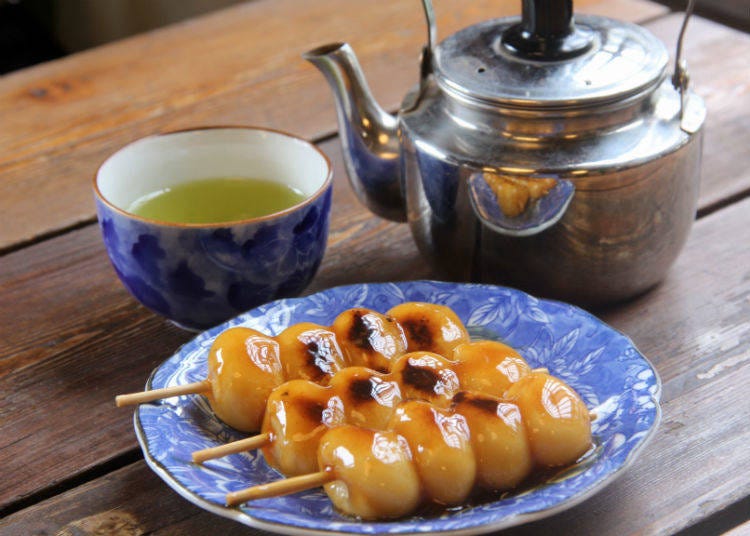
Goto Dangoya is a long-established dango (dumpling) store that first opened its doors in 1845. The current shopkeeper operates this Edo-period store in the family’s 7th generation!
The two most famous specialties of Goto Dangoya are yaki-dango, grilled dumplings, and an-dango, dumplings covered with sweet bean paste. Three dumplings of either type cost 450 yen. Goto Dangoya’s secret lies with the flour used for their little delicacies. Making use of mortar and pestle, probably the most traditional of techniques, the flour is grinded every day early in the morning, giving the dumplings a wonderfully soft, yet firm-to-the-bite texture. Of course, the sweet bean paste for the an-dango is handmade by the shopkeeper themselves as well.
Another recommendation is the “cream anmitsu” for 700 yen, a dessert of agar jelly, fresh fruits, rice cakes, and said red bean paste. During the summer months, shaved ice cream called “kakigori” isn’t just loved by travelers and worshipers for its nostalgic taste but also for being wonderfully refreshing.
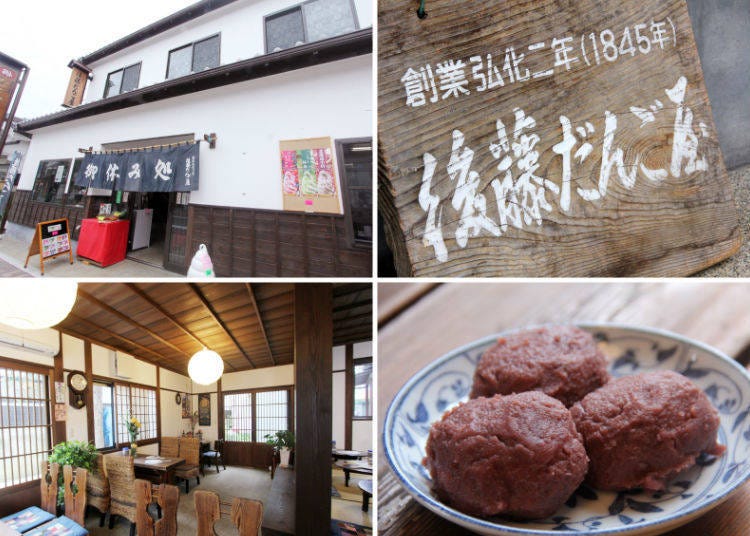
-
Goto dangoya後藤だんご屋
- Address 499 Kamicho, Narita-City, Chiba Prefecture, 286-0032
-
Nearest Station
Narita Station
- Phone Number 0476-22-2560
・Hours: 10:30 AM–5 PM
・Closed: Irregularly
・Access: 7 minutes on foot from Narita Station (JR and Keisei)
Miyoshiya: a Beautiful Journey to the World of Japanese Sweets
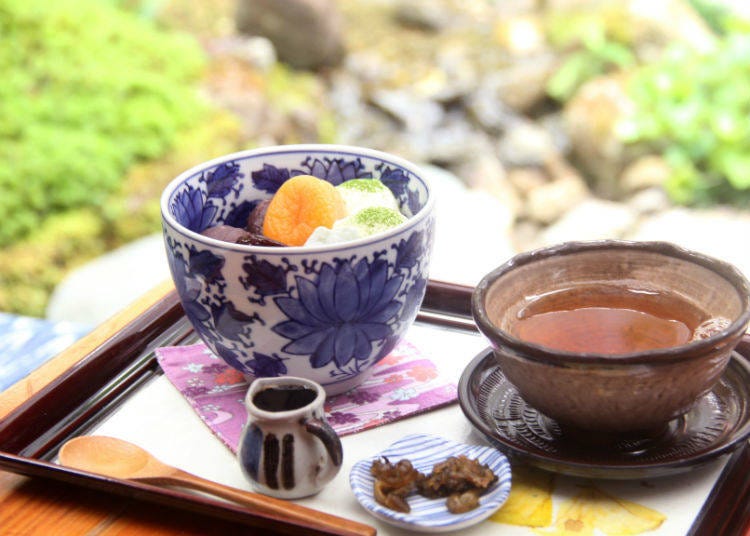
If you stray from the broad, lively temple approach called omotesando and enter a tiny, narrow alley, you’ll find Miyoshiya. This atmospheric Japanese café is one of the many hidden gems of Narita, surrounded by lush nature, flowers of all seasons, and a relaxingly gurgling stream. This calm, beautiful atmosphere emits the essence of Japanese harmony.
The center of the green garden is dominated by a glass house, while semi-open-air and counter seats invite you to rest your feet as well. Miyoshiya’s menu is all about traditional Japanese sweets and the shop is committed to using the finest ingredients for its delicious treats. One example is “oshiruko,” red bean soup that is available either hot or cold for 650 yen. The red beans that this all-time favorite is made of come straight from Hokkaido and are especially rich in flavor. Another recommendation is “shiratama azuki,” a dessert of mochi rice cakes and sweet red beans for 800 yen.
In general, the homemade rice cakes called mochi, available from 750 yen, are an absolute must-try if you decide to stop by Miyoshiya. Upgrade your sweet menu for 350 yen to get a hot cup of either coffee or matcha tea after your journey into Japan’s wonderful world of sweets and desserts.
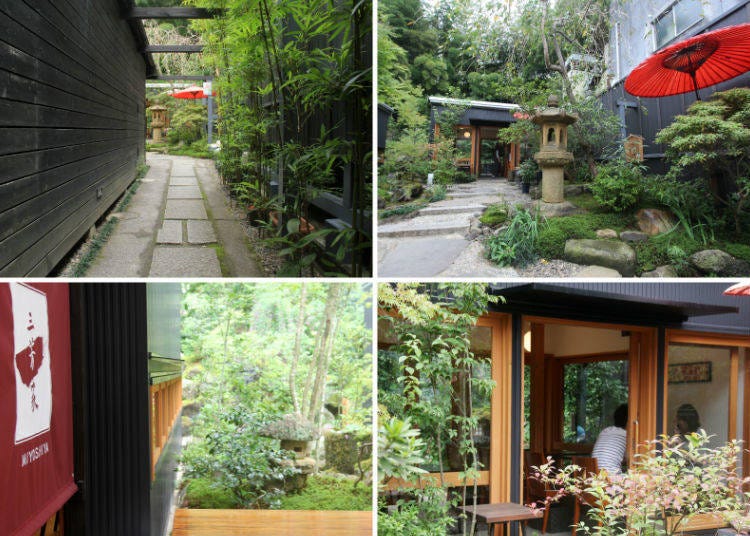
-
Miyoshiya三芳家
- Address 386-2 Nakamachi, Narita-City, Chiba Prefecture, 286-0027
-
Nearest Station
Narita Station
- Phone Number 0476-22-2147
・Hours: 10 AM–5 PM
・Closed: Wednesdays (open during January, May, and September)
・Access: 8 minutes on foot from Narita Station (JR and Keisei)
Edokko Sushi: Enjoying Authentic Sushi like the Japanese of Old
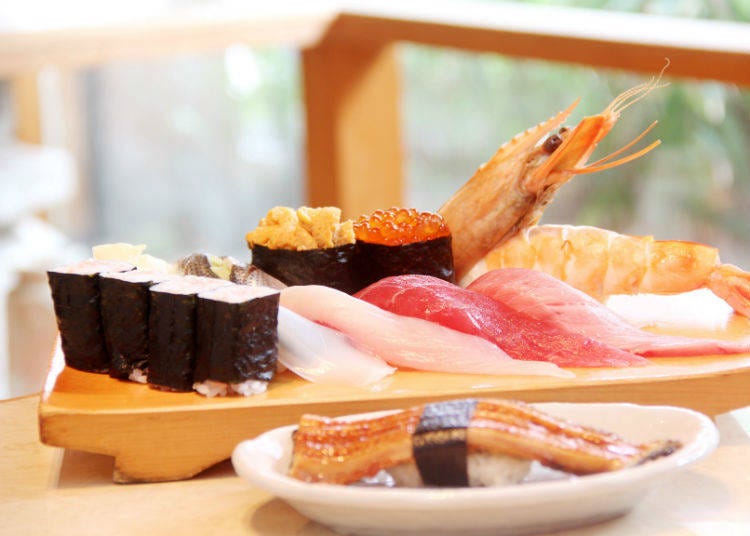
Edokko Sushi’s main store on the temple approach is an authentic sushi shop popular with both locals and tourists. Serving authentic Edo-style sushi, this place is Narita’s premier sushi restaurant. Not just the taste and ingredients of the many dishes convey the authentic spirit of Old Edo, so does the shop itself. The long counter is reminiscent of sushi restaurants of the past, inviting you to sit down and enjoy the many fresh seafood varieties like the Japanese of old.
The secret to Edokko Sushi’s popularity lies with the extreme freshness of their ingredients and the massive size of the toppings. Called “neta,” these sushi toppings tend to be twice the size of the rice underneath, making for both excellent photos and excellent taste. Next to the classic nigiri, especially the gunkan-maki, “battleship roll” is recommended. They are generously topped with a variety of different, fresh seafood choices – sea urchin and salmon roe being only two examples. Everything can be ordered by the plate, two pieces each, and the entire menu is available in English as well, making Edokko Sushi particularly tourist-friendly. Three kinds of sushi sets are also available: “take” for 1728 yen, “jo” for 1376 yen, and “tokujo” for 2808 yen.

-
Narita Edokko Sushi Sando Honten成田江戸っ子寿司 参道本店
- Address 536-10 Hanazakicho, Narita-City, Chiba Prefecture, 286-0033
-
Nearest Station
Narita Station
- Phone Number 0476-22-0530
・Hours: 11 AM–2:30 PM (Last order at 2 PM), 5 PM–10 PM (Last order at 9:30 PM)
・Closed: Mondays
・Access: 3 minutes on foot from Narita Station (JR and Keisei)
Nagomi no Yoneya: Tasting Yokan and the Sweet Side of Chiba
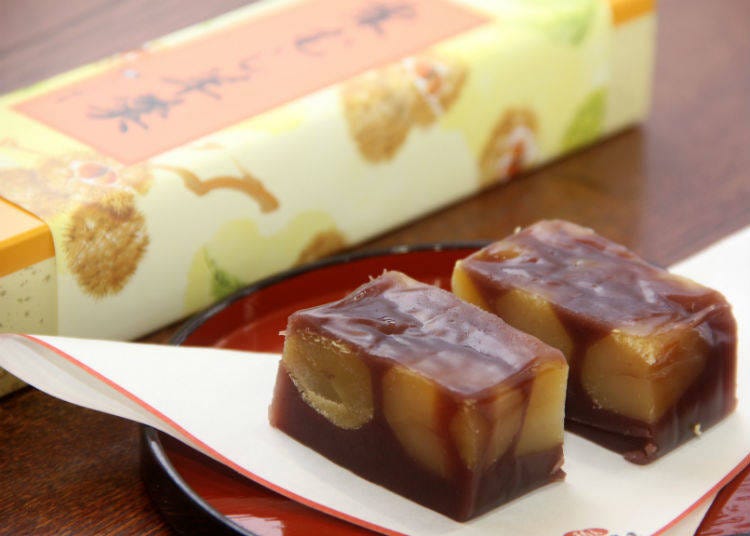
Nagomi no Yoneya was founded in 1899 and is famous for what has become the staple souvenir of a Narita pilgrimage: kurimushi yokan, a treat of steamed bean jelly and chestnut. This now famous delicacy has its roots in the vegetarian cuisine of Narita-san Shinsho-ji Temple itself and is loved for its gentle sweetness and whole, plump chestnuts. The second must-try of Nagomi no Yoneya is called dainagon-yokan, a yokan variety made with coarse red bean paste. The coarseness of the steamed jelly makes for an especially rich bean flavor and a sweet treat that is firm to the bite.
The store is filled with all sorts of traditional Japanese confectionery using Chiba’s – and especially Narita’s – local produce. All of them make for excellent souvenirs, conveying both the spirit and the taste of Japan. A particularly fun choice is the “peanut monaka,” crunchy wafers filled with sweet bean paste in the shape of a peanut. Nagomi no Yoneya also is home to the Narita Yokan Museum (10:00 a.m. – 4:00 p.m.) that showcases the history of the store itself and its famous yokan.
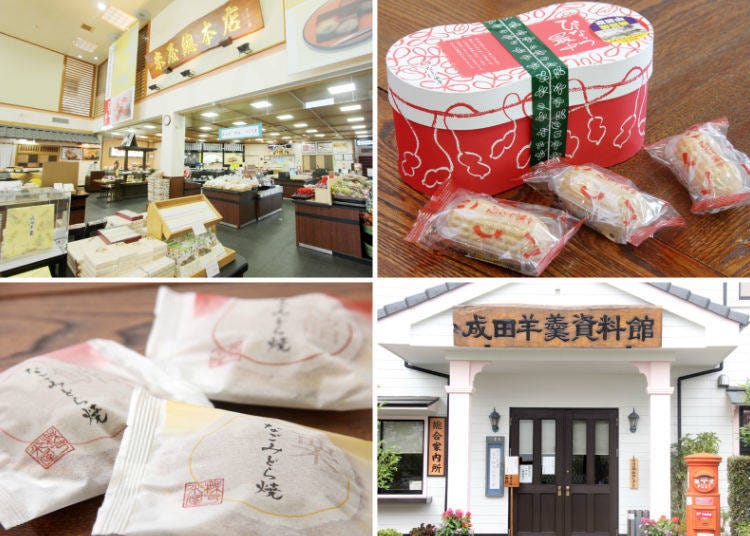
-
NAGOMI-YONEYAなごみの米屋 總本店
- Address 500 Kamicho, Narita-City, Chiba Prefecture, 286-0032
-
Nearest Station
Narita Station
- Phone Number 0476-22-1661
・Hours: 8 AM–6 PM (may vary)
・Closed: Open daily
・Access: 7 minutes on foot from Narita Station (JR and Keisei)
Sabon-sama: Narita’s Mysterious “Drops of Purification”
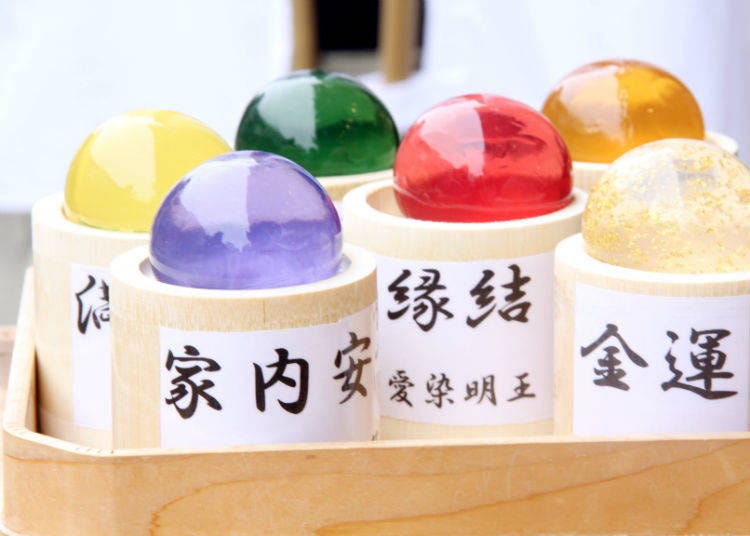
From tradition to trend: the facial soaps of Narita’s soap shop “Naritasan Omotesando Sabon-sama” is the latest craze in the world of skin care. The jelly-like soap orb contains tamarind, a fruit lauded for its moisturizing effect. Called “Okiyome no Tama,” literally Drop of Purification, this fun, interesting soap comes in six different varieties – kohaku (amber), smelling wonderfully of fragrant olive, and edomurasaki (royal purple) with an aroma of lily of the valley. They all are created with different needs and types of skin in mind, such as a beautification effect, for dry skin, or with a particularly strong moisturizing effect.
The most popular among the jelly-like soap orbs is “kinrenge,” or golden lotus. This soap is blended with gold and has a rich aroma of sandalwood. Additionally, the vivid soaps are closely connected to Japan’s culture of color, so the soaps’ boxes indicate things like the safety of one’s home, marriage, the fulfillment of a wish, and so on. Unless you’re looking for a product that fulfils a specific need, feel free to choose based on aroma and color alone. Sabon-sama also offers various basins to try the many different soaps, so do take your time and find what suits you best.

-
Sabonsama成田山表参道さぼんさま
- Address 387 Nakamachi, Narita-City, Chiba Prefecture, 286-0027
-
Nearest Station
Narita Station
- Phone Number 0476-29-4447
・Hours: 9:30 AM–5 PM (until 5:30 PM on Saturdays, Sundays, and national holidays)
・Closed: Open daily
・Access: 8 minutes on foot from Narita Station (JR and Keisei)
Chomeisen Sake: “Source of Long Life”
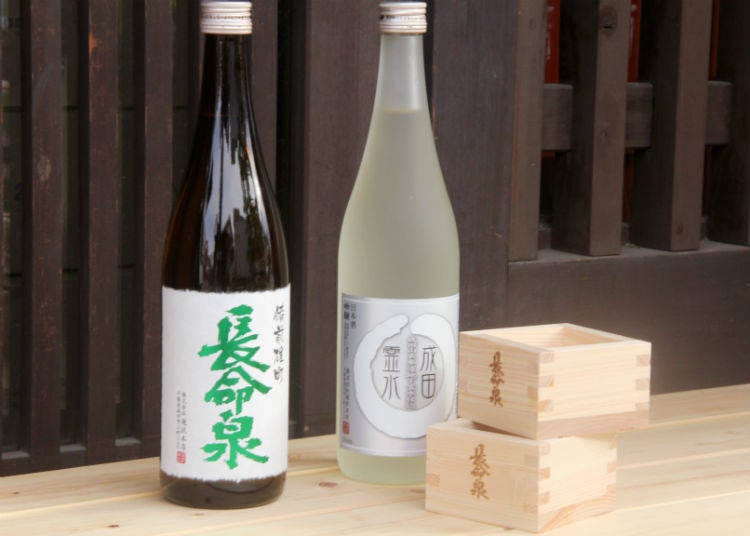
Our next stop is at Narita Omotesando’s only sake brewery, Chomeisen. Operating since 1872, it’s a long- and well-established brand that makes its sake with water from a well that is rumored to cure illnesses. This is where its name comes from – “chomei” means “long life.”
Chomeisen’s most-loved product is a dry, easy-to-drink sake called “Narita Reisui,” made with brewer’s rice from Chiba Prefecture. For those who like it sweet and with a strong aroma, we recommend the “Chomeisen Ginjo Junmai Bizen Omachi.” Smaller-sized bottles – 180 ml and 300 ml – are also available, ready to be picked up and gifted to your sake-loving friends and family at home.
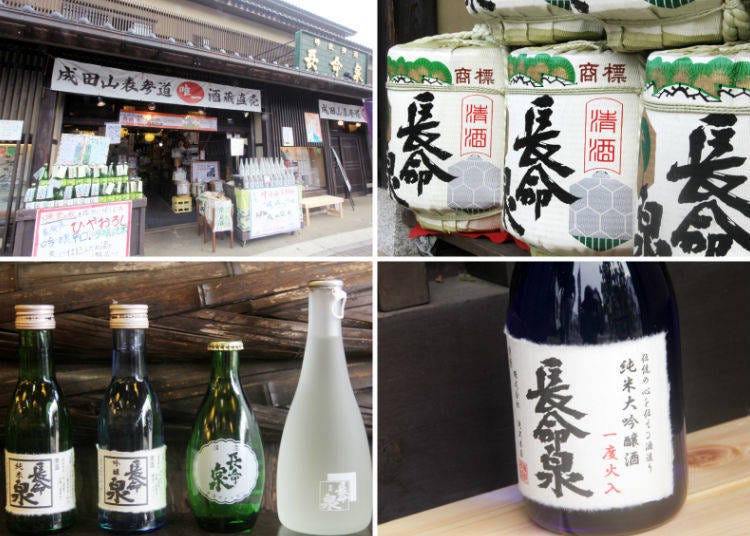
-
Chomeisen長命泉蔵元 滝沢本店
- Address 540 Kamicho, Narita-City, Chiba Prefecture, 286-0032
-
Nearest Station
Narita Station
- Phone Number 0476-22-8417
・Hours: 10 AM–7 PM (opens at 9 AM on Sundays)
・Closed: Open daily
・Access: 5 minutes on foot from Narita Station (JR and Keisei)
Narita-san Shinsho-ji Temple: Celebrating the Buddhist God of Fire with Ancient Ceremonies
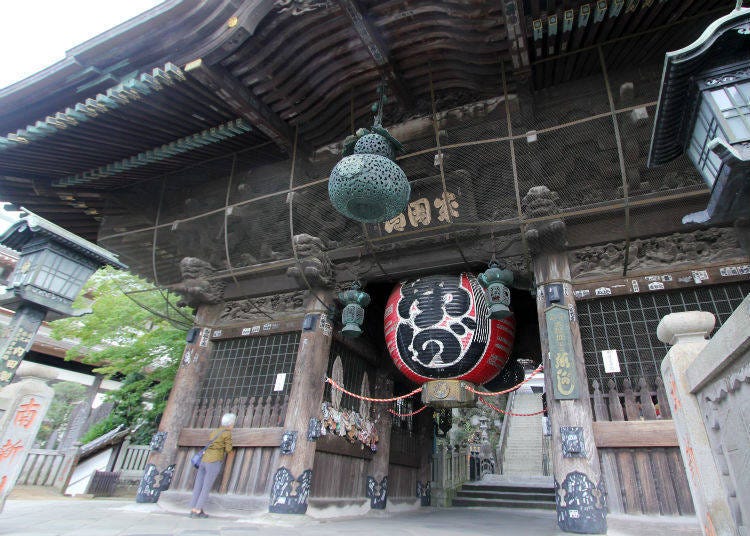
Narita-san Shinsho-ji Temple was founded in 940 as a temple of the Buddhist Shingon Sect. It also is one of the greater Tokyo area’s most popular spots for hatsumode, the Japanese custom of visiting a shrine or temple on New Year’s Day. Three million people journey to Shinsho-ji each year for this occasion.
The spacious precincts of the temple are dotted with various buildings, such as the Niomon Gate constructed in the Edo period (1603 – 1868), the Three-story Pagoda, Shakado Hall, Gakudo Hall, or the Komyodo Hall – those five buildings are all designated as important cultural properties of Japan. The main hall is home to the main statue of Fudo Miyo-o (Acala), an important Buddhist guardian deity. Here is also where the “goma prayer” takes place, a custom that has been taken place between five to eight times every single day, faithfully continued for almost 1080 years. Worshipers and visitors are both welcome to witness this ritual, as long as you make an effort to be respectful and quiet.
Komyodo Hall, between the Great Main Hall and the Great Peace Pagoda, is dedicated to Aizen Myo-o (Ragaraja), a Buddhist deity of love. Thus, it is a popular spot for couples coming to worship, said to be a power spot for fortune in marriage.
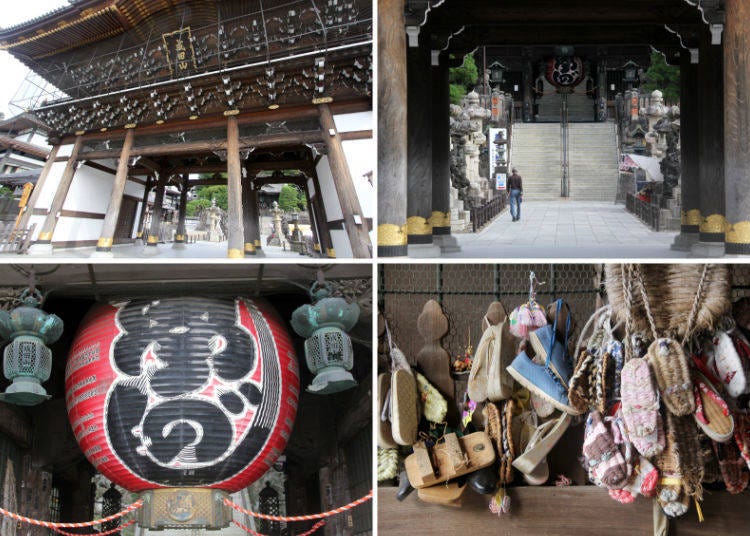

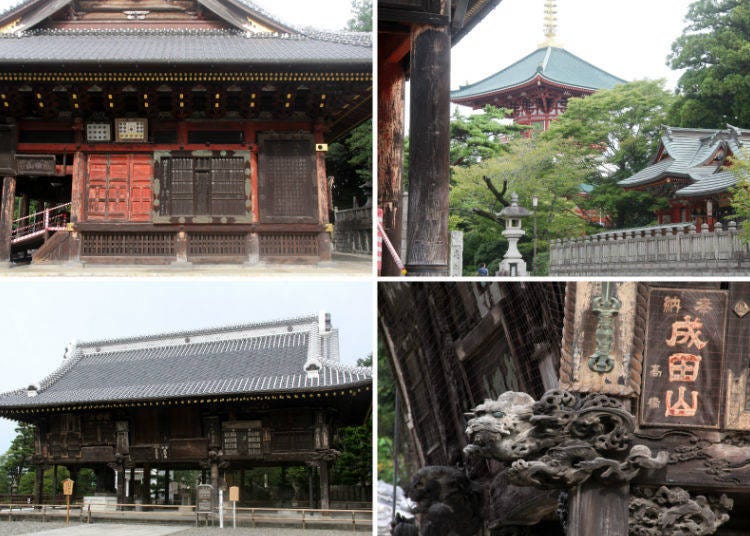
-

-
Address
1, Narita, Narita-shi, Chiba, 286-0023
View Map -
Nearest Station
Narita Station (JR Narita Line)
10 minutes on foot
- Phone Number 0476-22-2111
-
Address
1, Narita, Narita-shi, Chiba, 286-0023
- Area
- Category
*Prices and options mentioned are subject to change.
*Unless stated otherwise, all prices include tax.
Popular Tours & Activitiess
Recommended places for you
-

Get Ready to Catch 'Em All! First Ever Permanent Outdoor Pokémon Park Opening Near Tokyo!
-

Enjoy Japan's Gorgeous Winter Lights! Ride the Romancecar to Shonan no Hoseki Illumination
by: Guest Contributor
-

[Extended Offer!](12% OFF KKday Coupon) Mt. Fuji Autumn Leaves, Powder Snow & More! 15 Best Tours to Experience Japan in Fall & Winter
-

LaLaport TOKYO-BAY North Building Now Open: Shop, Dine & Enjoy Events at LaLa arena, Just 2 Stops from Disney
by: Wemmy Chau
-

Don't Miss Out! The One Thing You Must Do Before Shopping at Mitsui Shopping Park LaLaport: Get Your Max 10% OFF Coupon Book
-

A Travel Game Changer! Go Hands-Free Between Tokyo and Kyoto with LUGGAGE EXPRESS by JTB and JR Tokai
by: Guest Contributor
Inspiration for Accommodations
-

Enjoy Mt. Fuji from the Comfort of Your Room! Recommended Ryokan with Mt. Fuji View
-

Stay Near the Cherry Blossoms! Hotels for Cherry Blossom Viewing in Tokyo
-

Family-Friendly Hotels with Free Shuttle to Disneyland: Convenient Access for a Magical Stay
-

Top Ranked Hakone Hotels with Mt. Fuji View: Enjoy Stunning Scenery from Your Private Space
-

Convenient Tokyo Hotels with Airport Shuttle: Ideal for Families and Heavy Luggage
-

Stunning Tokyo Tower View Hotels: Enjoy Spectacular Scenery from Your Private Space
-

Convenient Asakusa Hotels with Kitchens: Ideal for Extended Family Visits
-

Experience Luxury: Hakone's 10 Best Five-Star Accommodations
-

Enjoy Mt. Fuji Autumn Leaves! Top Hotels Near the Popular Autumn Leaves Corridor
-

Experience Hakone Fall Foliage from Your Room with Stunning Views
-

Tokyo Train Map: Your Essential Guide to Subways and Railways
-

Discover The Dreamy Historical Village of Omori - Home to World Heritage Iwami Ginzan Silver Mine (Shimane Prefecture)
-

4 Best Historic Neighborhoods to Experience Old Tokyo
-

Japan's Bath Culture: Tips You Should Know!
-

Explore a historic samurai district while wearing kimono in Kagoshima, southern Japan
-

This is the way to get around in Tokyo Station at the first time!
- #best ramen tokyo
- #what to buy in ameyoko
- #what to bring to japan
- #new years in tokyo
- #best izakaya shinjuku
- #things to do tokyo
- #japanese nail trends
- #what to do in odaiba
- #onsen tattoo friendly tokyo
- #daiso
- #best sushi ginza
- #japanese convenience store snacks
- #best yakiniku shibuya
- #japanese fashion culture
- #best japanese soft drinks




















